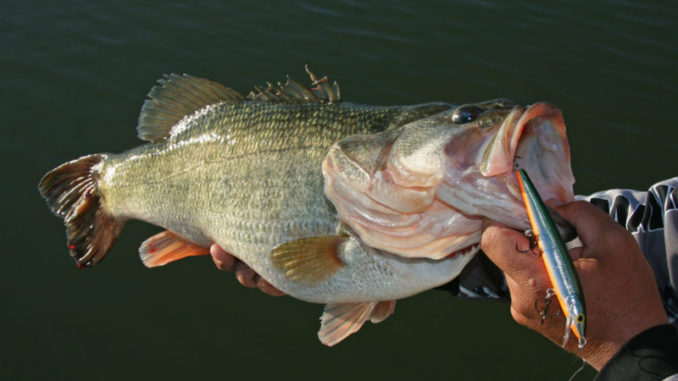
Jerkbaits are an angler’s top weapon this month
Not too many bass fishermen think about February as being a great month to get on the water, but if you’ve finished the boat shows and got all your tackle in order, you can catch some fish if you understand the problems involved.
Fishing is better in the winter on certain lakes, lakes with clear water like Norman, Badin, Tillery or Buggs Island. The main thing is, in clear water, fish seem to be a little more aggressive than they are in colder, muddy water; you’ve almost got to hit the fish in the head when it’s like that.
You can fish lakes that have hot holes like Norman and Wylie, where the water temperature around them can be seven, eight or 10 degrees warmer than anywhere else on those lakes. And at Norman, you’ve got spotted bass; they are more active, more aggressive in cold water, than largemouths.
Water temperature is really the key, however. You want to try and stay out of water that’s in the low 40s, because you’re not going to catch much. You want water that’s in the upper 40s. February is a time of year when water temperature plays a key part. Every little bit makes a difference; there’s a huge difference between 47 and 49 degrees. A lot of time, if it’s 47 or 48, you’ve got to make real slow retrieves. If it’s 49 or 50, you can fish the way you normally do.
One good thing is, fish are going to be looking up in February. The shad are up there toward the surface, and in the cold, they’re sluggish, affected, even dying. Bass have been dormant in December and January, not feeding a lot. If it starts to warm up, they get a little more active.
Top 4 lures this month
Four lures can catch a lot of fish in February: jerkbaits, lipless crankbaits, medium-running crankbaits and spinnerbaits. Spinnerbaits can catch fish if you work them real slow, a bait with a single, thumper blade. Lipless crankbaits work when they get a little more aggressive, when the temperature gets close to 50.
Jerkbaits are No. 1. There are a lot of good ones: a weighted Rogue, a Long A Bomber, a Storm Slap Stick — any of the Lucky Craft baits are good. I like Tennessee Shad, almond/black and almond/blue as colors. You fish them with the same action as a dying shad; jerk it a little bit, then let it sit. The key is them being weighted so they don’t float up; Fish will come from 10 to 12 feet deep to hit them if the water’s clear.
You reel the bait down a couple of feet, then jerk-jerk it with your rod tip, then stop and take up the slack. You want the bait to sit there, not float back up, just suspend. One thing that helps is fishing them on fluorocarbon line. I’ll fish them on 10-pound, Trilene 100-Percent Fluorocarbon. It will get baits to suspend a little longer, a little better, and that makes a big difference on a jerkbait. I fish a jerkbait and a lipless crankbait on a 7-foot, medium-heavy fiberglass Lew’s cranking rod and a Lew’s 51 baitcasting reel.
When you’re fishing a lipless bait, you’ve got to figure out how they’re going to want it. On a cold, overcast day, you have to fish it more slowly. If it’s a bright, sunny day and the water’s warmed up a little bit, you can fish it a little faster.
Yo-yo, or pull-wind?
A half-ounce bait is probably best, and it’s probably better when it’s fished with a yo-yo retrieve. You pull it with the rod tip, reel in the slack, pull it and reel it, not letting it hit the bottom. That seems to work better in clear water. I don’t like to burn them. When the water temperature reaches 52 or 53 degrees, you need to go ahead and wind ’em. If it’s in the 40s, you yo-yo ’em; it’s really the same action with a jerkbait and really, the same action with a crankbait. A pull-wind retrieve is the best return in the winter. You pull the crankbait with the rod tip and reel up the slack. You’re getting the bait down, stopping it and letting it suspend. The colder the water, the longer you suspend it.
Where do I fish in February? I like to fish the lower end of lakes, because the water will be clearer. I fish riprap, rock, channel brush. They’ll move up on flatter-type banks, but that’s usually in March. And you want to be on the main lake in February. There may be some resident fish that never leave the backs of the creeks, but most of the big fish will be caught out on the main lake. You want to fish shallow, close to deeper water, and you always want to be fishing around rock. If you go back in a creek, you look for big spawning areas and work your way out to that kind of structure.




Be the first to comment